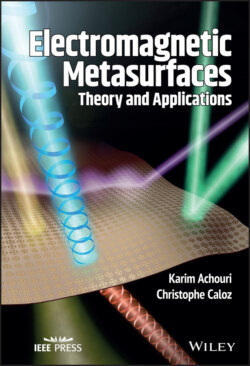Читать книгу Electromagnetic Metasurfaces - Christophe Caloz - Страница 18
2.4 Lorentz Reciprocity Theorem
ОглавлениеReciprocity or nonreciprocity is a fundamental physical property of all media, structures, devices, and systems. “A nonreciprocal (reciprocal) system is defined as a system that exhibits different (same) received–transmitted field ratios when its source(s) and detector(s) are exchanged” [28].
A linear-time-invariant (LTI) system can be made nonreciprocal only via the application of an external bias field that is odd under time reversal, such as a magnetic field or a current. The most common example of a nonreciprocal device is the Faraday isolator, whose nonreciprocity is obtained by biasing a ferrite with an external static magnetic field [143].
This section derives the Lorentz reciprocity theorem for a bianisotropic LTI medium, which provides the general conditions for reciprocity in terms of susceptibility tensors. These relations naturally apply to LTI metasurfaces as well.
Let us consider a volume enclosed by a surface and containing the impressed electric and magnetic sources and , respectively. In the time-harmonic regime, these sources are related to the fields , , , and via Maxwell equations,
(2.39a)
(2.39b)
Similarly, the phase-conjugated impressed sources,5 and , are related to the phase-conjugated fields , , , and as
(2.40a)
(2.40b)
Subtracting 2.39a pre-multiplied by from 2.40b pre-multiplied by , and subtracting 2.40a pre-multiplied by from 2.39b pre-multiplied by yields
(2.41a)
(2.41b)
Using the identity reduces these equations to
(2.42a)
(2.42b)
Subtracting 2.42a from 2.42b yields
(2.43)
We may now integrate this equation over the volume and apply the Gauss theorem, which gives
(2.44)
The surface integral on the left-hand side of (2.44) and the second volume integral on its right-hand side both vanish when integrated over an unbounded medium [28, 81]. This results into
(2.45)
which represents a fundamental relation for reciprocity. We next include the bianisotropic material parameters in this relation. For this purpose, we use the bianisotropic constitutive relations (2.4), which may be explicitly rewritten as
(2.46a)
(2.46b)
where represents a time-odd external bias. Under phase conjugation (or time reversal), these constitutive relations become [28]
(2.47a)
(2.47b)
Substituting (2.46) and (2.47) into (2.45) transforms the integrand of (2.45) into
(2.48)
Expanding the bracketed terms in (2.48), using the identity , where the superscript denotes the transpose operation, and grouping the identical parameter terms, we obtain
(2.49)
The nullity of the volume integral of (2.49) (Eq. (2.45)) for any field implies then the general6 bianisotropic Lorentz reciprocity conditions
(2.50a)
(2.50b)
In the absence of external bias, i.e. , these conditions reduce to
(2.51)
which may be expressed in terms of susceptibilities as
(2.52)
